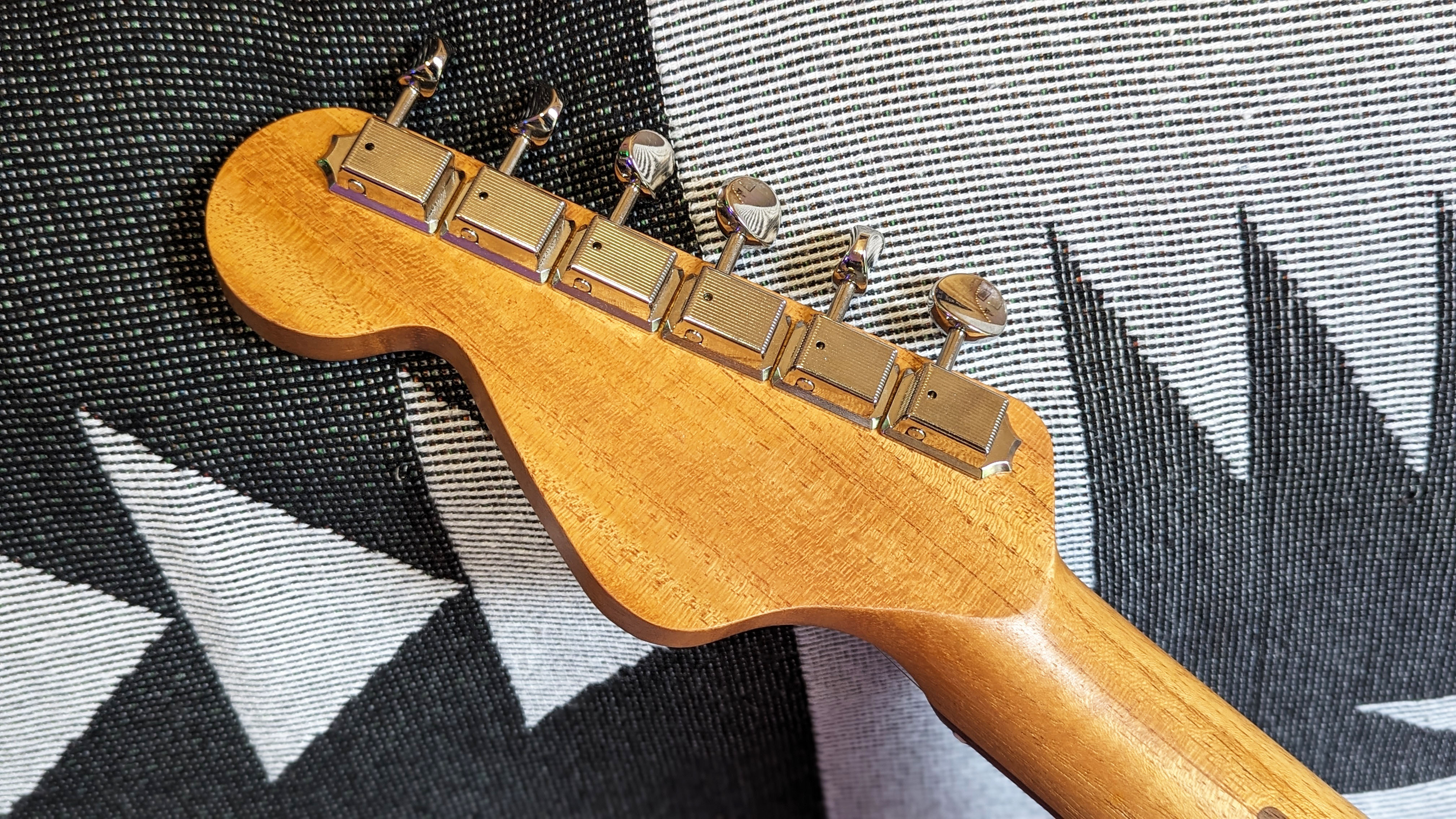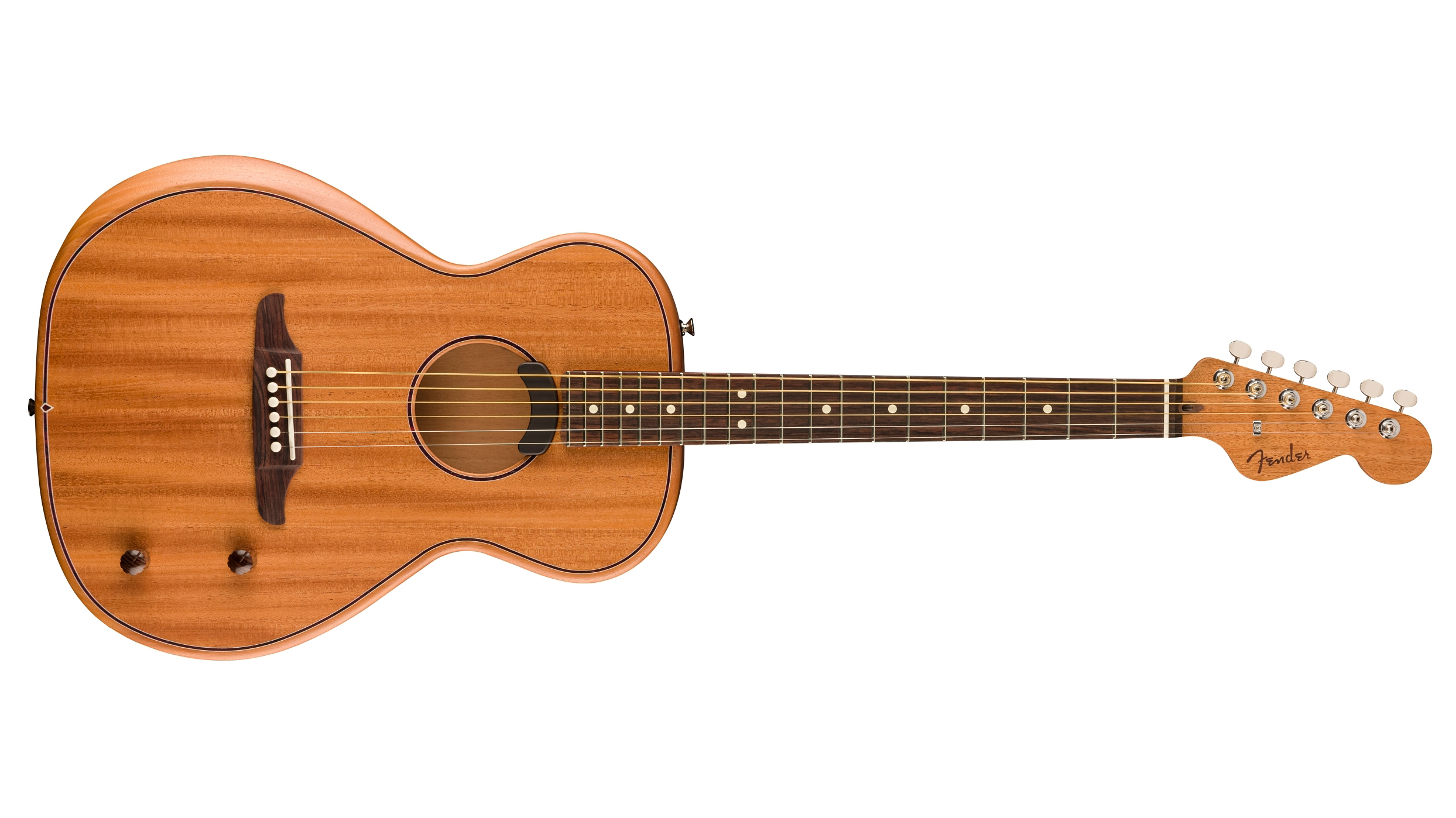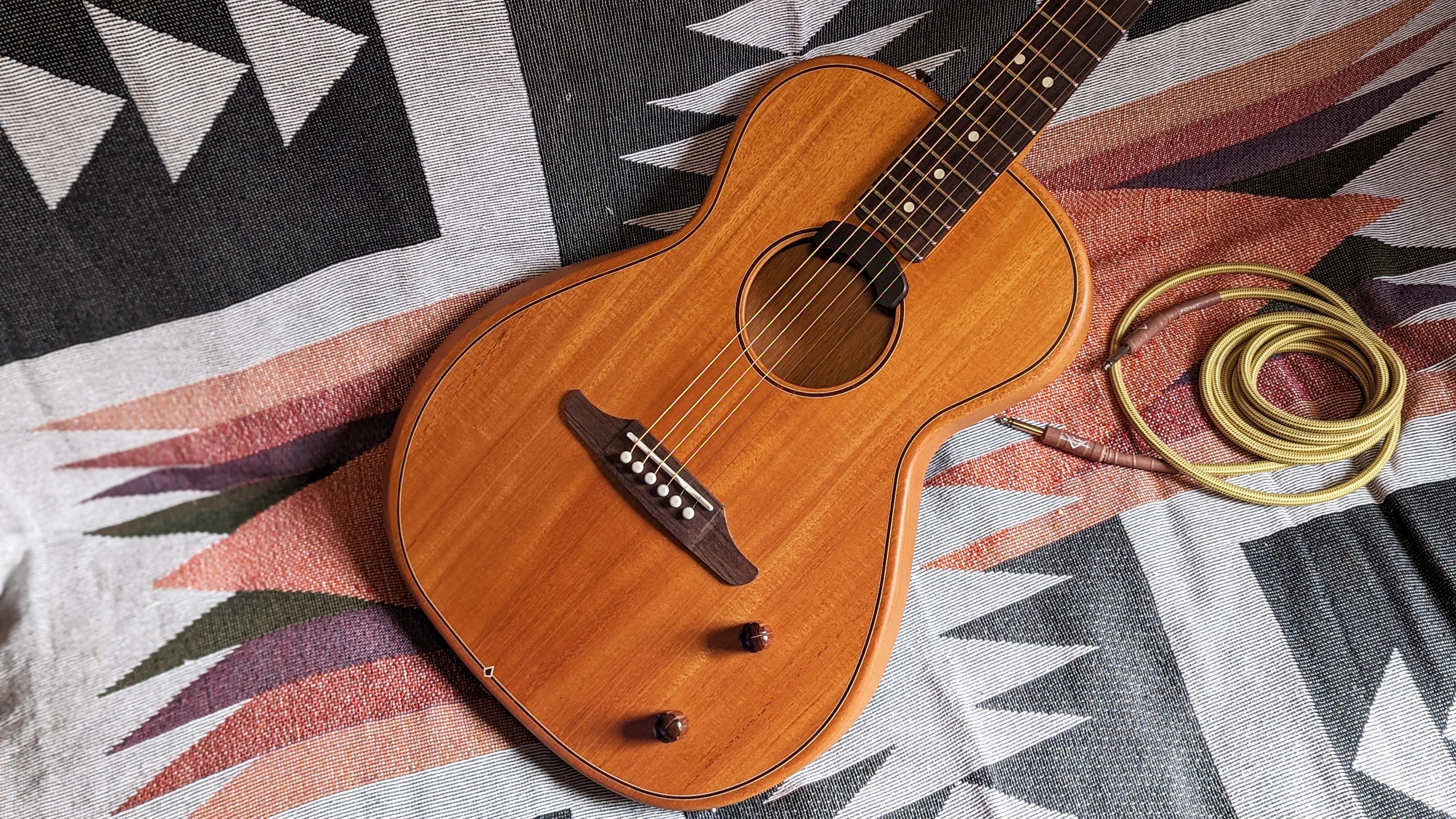MusicRadar Verdict
An interesting idea that delivers more appealing 'acoustic' plugged-in sounds than anything we've heard from Fender before. The sticking point for winning players over to its charms could be the price, but the playability and plugged-in sounds very much stand up for us
Pros
- +
The best plugged-in acoustic tones we've heard from Fender
- +
More accessible playability than most acoustic guitars
- +
Micro-tilt gives more control over setting it up
Cons
- -
It's a little pricier than we would have hoped
- -
Unplugged tones don't rival a full-depth parlor acoustic
MusicRadar's got your back
Fender Highway Series Parlor: What is it?

Fender is on a mission. As much as the company does to please traditionalists with guitars that echo the specs of its roots with the Vintera and American Vintage series, it has another, bolder side and it's not afraid to realise it.
We've already seen a full dive into amp and multi-effects modelling this year with the Tone Master, and even an impressive FRFR cab for that market. But we're back to guitars now, and it's not so much a follow-up to the Acoustasonic as a different path to woo acoustic guitar players.
While the US and Mexican Acoustasonic guitars were hybrid guitars with piezo and magnetic pickups capable of electro-acoustic and electric guitar tones, the Highway Series has only one pickup; a magnetic soundhole design that continues Fender's collaboration with Fishman but focusses on the ongoing challenge of making an acoustic guitar sound like one when amplified.

The Highway Series features a Parlor and larger Dreadnought model in Spruce and Mahogany top iterations. Their bodies obviously look more like the familiar outline of acoustic guitars than the electric shapes of the Acoustastonic Jazzmaster, Tele and Strat, but these are still thin-bodied models. Not as thin as the Acoustastonics but at 2.25" (57.15mm), still obviously thinner than traditional parlor and dreadnought flattops. Therefore they won't sound like them unplugged, and the emphasis is still on the plugged-in experience.
The headstock is the Strat-type design that echoes Fender's bold '60s designs with German master luthier visionary Roger Rossmeisl. An aesthetic approach still used today in some of Fender's acoustic lines.

There's a sense that decades later, acoustic guitars are still a bit of an overlooked sideline for Fender. There's no real iconic Fender acoustic in the sphere of the J-45 and D-28. But the truth is the company has been producing some excellent, accessibly-priced acoustic guitars for years. More recently its Paramount series of traditionally-appointed dreadnought, parlor and orchestra guitars helped set a standard for solid wood value for electro-acoustics.
From my perspective, Fender remains a bit of a dark horse of acoustic guitars, and it's now gained more attention for its hybrid Acoustasonic designs. I wonder if the Highway Series could bridge those worlds; bringing forward-thinking design to the open-minded but also a new approach that could attract more acoustic-focussed players onboard. Players who are always looking for a 'better' live guitar sound.
Fender Highway Series Parlor: Performance and verdict

The most positive memories of my experiences with Acoustasonic guitars are just how comfortable they are to hold and play; it's not just the fact it's an electric guitar neck, but a really inviting one. And that's also the case here; the radius is the same 12", with a smooth satin urethane finish at the back. It's described as a C-shape carve, rather than the more specific Modern 'Deep C' of the Acoustasonic. It feels slightly wider to me, though the nut width is the same 42.86mm. The lack of cutaway obviously restricts higher fret access much more than the Acoustasonic.
The bolt-on construction also allows for the same degree of adjustment; not just a truss rod nut but Micro-Tilt too. The latter is an unfairly maligned design from the CBS '70s days that combines a three-bolt neck plate with a metal plate in the neck pocket, adjusted via a small fallen key slot. It's an adjustable neck shim and allows you to fine-tune a set up, especially useful after a change in string gauge. You just need to loosen the bolts first.

All this adds up to more accessible playability and enhanced control compared to a traditional acoustic guitar. What it can't do is compete with the unplugged low-end response that a larger acoustic body (and thicker) neck provides.
The Parlor Highway Series is unsurprisingly louder than an Acoustasonic unplugged, thanks to its larger body and soundhole, and its bright and punchy character sounds resonant enough around the house. It's not something you're likely to mic up though, but that's not the point. This is a guitar primarily aimed at live use, though the edgier character couples well with the sense of fretboard freedom from the neck to make for a go-to home instrument.

The Highway Series Parlor is very different guitar to the Acoustasonics plugged in. In addition to a magnetic pickup for the electric tones, those models offered a piezo undersaddle for the acoustic voices, and in the case of the American Acoustasonics it could be combined with a third pickup; a transducer body sensor. Even with the Fishman modelling 'images' (Fishman's take on IRs) that could be mixed in with the Acoustasonic piezo, the source was still reliant on the undersaddle piezo. That's not the case here where it's a Fishman Fluence soundhole pickup placed near the base of the neck.
It's described as 'all analog' too, which makes the warm lows and rounded highs all the more impressive, suggesting there's some EQ processing going on. It sounds more like an acoustic guitar plugged in than the Player Acoustasonic models, and even makes the higher strings of my own parlor guitar with a Fishman M1A soundhole pickup sound more compressed in comparison.


It needs minimal treatment; I'm plugging into a flat response speaker with a Fishman preamp pedal with everything set flat to simulate a pretty minimal live setup. Out of the box, this would be a really impressive sound to turn up to an open mic with, and the Contour control offers you the opportunity to move between two EQ extremes. Actually, extreme is probably too strong a word, it's subtler than that. One offers the warmest low end, but even the opposite is nowhere near the brittle sounds you might be used to with piezo compression. It's a boxier character often associated with parlor guitars.
The other side of that coin is it can lack the cut some players lean into with piezo pickups for in a band mix. That's something the Acoustasonic Player was good at and sometimes what seems less pleasing in isolation can hold its own when bass and drums come into the picture. Some external EQ and compression can help with that. And although the plugged-in sound defies the Highway Series Parlor's shallow dimensions to some degree, it's still no match for the overall presence of a full-size acoustic. But it can certainly sound more pleasantly mellow than some straight out of the box.

If these acoustic tones were combined with the Acoustasonic's magnetic pickup, you might have a very interestingl live instrument in your hands. But my feeling is you're getting less electronics and sonic options here, and in fairness it's $200 less than the Player Acoustasonics. But it might prove an even more challenging value proposition for guitarists who are on the fence.
I think it looks good. I like the more minimal approach to acoustics and the tort pattern purfling is a nice subtle touch (the Spruce model has the kind of checked style that echoes the Paramount series). I think it would have been good to offer some top finish options out of the gate though; solid colours and sunburst. PErhaps they will come later as we see the line expand.
The headstock may well turn off some acoustic players, but its sound will rival similarly-priced full-depth acoustics plugged in, and indeed better many. The key caveat is a lot of those guitars can also be mic'd for recording because their physicality delivers a fuller sound unplugged. This is a $1,000 guitar that can't be used for that to get impressive results.

There is something to be said for the way it could fit into an electric guitar player's life, both for playability and its impressive feedback resistance
For me that's where Fender's challenge lies with the Highway Series. Clearly it's not the hybrid concept of the Acoustasonic; it's a guitar that will benefit acoustic players live, not those looking to cross the streams. Having said that, there is something to be said for the way it could fit into an electric guitar player's life, both for playability and its impressive feedback resistance.
I tried it out with my pedalboard using a UAFX Dream '65 amp emulator and came away impressed. Though there's definitely a physical fullness that my Auden parlor brought to the table. Fender and Fishman are clearly onto something with this pickup design. I'd be intrigued to hear it in a full-size flattop, though as the Highway Series' USP I can't see that happening. What could be interesting in terms of additional acoustic options would be a combination of the soundhole Fishman Fluence pickup with an undersaddle piezo or transducer in a future Acoustasonic model. You never know!
Any guitar purchase needs to be justified in our minds as players, or so we tell ourselves when temptation comes calling. And $1,000 is a substantial outlay. The appeal of anything will usually depend on the desire and need, and I believe the primary role of the Highway Series is an electro-acoustic guitar with a more electric playability and a dependable sound for the stage. If you're using it only at home? Well it's you're money, and if you can afford it you'll certainly be getting a lovely-playing guitar here.
MusicRadar verdict: An interesting idea that delivers more appealing 'acoustic' plugged-in sounds than anything we've heard from Fender before. The sticking point for winning players over to its charms is the price, but the playability and plugged-in sounds very much stand up for us.
Fender Highway Series Parlor: Hands-on demos
Fender
Andertons
Fender Highway Series Parlor: Specifications

- TYPE: Electro-acoustic guitar, made in Mexico
- BODY: Solid mahogany top, chambered mahogany body
- NECK: Mahogany, C-shape
- SCALE: 25.5”
- FINGERBOARD: Rosewood, 12" radius
- FRETS: 20, Narrow Tall
- ELECTRICS: Fishman Fluence acoustic pickup
- CONTROLS: 1x Volume, 1x Contour
- HARDWARE: Modern Viking bridge, Fender ClassicGear tuning machines
- WEIGHT OF REVIEW GUITAR: 5.2lbs / 2.3kg
- CASE: Deluxe 1225 gig bag
- FINISHES: Mahogany (as reviewed), Spruce top
- CONTACT: Fender

Rob is the Reviews Editor for GuitarWorld.com and MusicRadar guitars, so spends most of his waking hours (and beyond) thinking about and trying the latest gear while making sure our reviews team is giving you thorough and honest tests of it. He's worked for guitar mags and sites as a writer and editor for nearly 20 years but still winces at the thought of restringing anything with a Floyd Rose.
With its latest free update, Ableton has finally turned Note into the app I always wanted it to be
Technically capable, but struggle to make your tunes sound musical? 5 simple music theory hacks to make your tracks stand out
"Despite its size, it delivers impressive audio quality and premium functions as well as featuring a good selection of inspired sounds": Roland GO:Piano 88PX review










